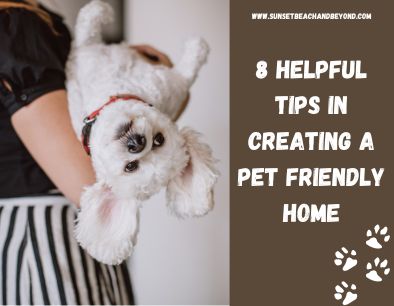In areas that are popular destination for pet owners such as Sunset Beach as well as towns dotted along the coastline of both North and South Carolina, there is a popular trend with a focus on designing pet friendly homes, known as “barkitecture.” For many, pets are an integral part of the family, as they are among the main occupants of prime real estate in one’s home. Pet owners are no longer holding back when it comes to designing a practical and special space that not only suits them, but their furry companions as well. From fabrics and flooring to safety features and dedicated corners, there are many tips and tricks to consider when designing a pet friendly home with added creativity. While a day spent playing fetch at the beach seems idyllic, coming home to a space that is comfortable and cozy for everyone is hard to beat.
Tips for Creating a Pet Friendly Home
 1. Pet Friendly Flooring
1. Pet Friendly Flooring
If you are not a fan of carpet, then having non-slick flooring installed in your home is non-negotiable. Slippery floors are hard on the joints, particularly in larger dogs making them the opposite of pet friendly. Tiled flooring is a great option as it provides additional grip. When designing your living space, we recommend avoiding smooth, slippery marble and hardwood floors that are scratch-prone. Some scratch-resistant flooring options include laminate and even hardwood with a stronger finish.
2. Cozy Corners
Like everyone else, furry friends also need moments of solitude. Negative areas can be utilized to create custom dens, such as the space beneath your stairs. Newer apartments come with box rooms, duct areas, and storage rooms that can be easily converted into cute corners for pets, their very own pet friendly space. Some pets might experience separation anxiety, and many might only require a cozy bed in a select spot in your bedroom or lounge, where you are in their line of sight.
3. Fabrics and Furnishings that are Fur-Free
Eve Alexander with Buyer’s Broker of Florida adds this: “Occasional messes and pets go hand in hand. For maintenance, shortlist stain and spill-resistant fabrics like microfibers, Crypton, denim, canvas, leather, and smoother fabrics that don’t draw attraction of claws. Velvet and suede are magnets for fur, where patterns and texture textiles help camouflage pet hair and minor scratches or stains. Materials that are two tones can help give the appearance of not being dirty. No matter the choice in furnishings or furniture, keep a spray-on fabric protector handy and get tailored slipcovers.”
4. Tread with Caution with Carpets
Rugs and carpets can tie in elements of a room together. However, they can easily harbor ticks, dander, and fleas. If either or both are a must for your space, we recommend opting for darker shades and vacuuming regularly. Essential oils like lemongrass, geranium, and citrus can help deter ticks and fleas. Shaggy carpets are an interesting choice as well, considering hair can easily get lost within the texture and length.
5. Decor and Furniture
Multifunctional furniture such as ottomans that provide additional storage, or coffee tables with built-in pet beds should be considered. Furniture with glass or flimsy fittings can be a risk. Heavy stone or metal pieces that won’t topple easily when bumped into by pets when playing might be a great option. Pet friendly furniture can help your companions feel at home when blending in with your interior style.
6. Special Added Installments
For other pets such as inquisitive cats or protective dogs, perches near windows can be a cool installation. Furniture-style dog crates made of wood are popular, and for smaller pets, a kennel placed within the wall like a fireplace can be chic. Door flaps are a fun addition to allow pets free movement in and out of the house, one of the most simple and yet common pet friendly features.
7. Safety First
Many pets are akin to furry babies, and apart from the more obvious inclusion of grills around windows and balconies, railing heights should be thoroughly considered. Electrical points should be concealed, as well as cords to be kept out of reach of pets, lest an inquisitive cat or puppy starts to play with them. Pet gates should ideally be installed to manage their movement, and those with a green thumb should be mindful of potentially harmful plants that are poisonous to pets. Furniture with rounded edges and fragile items such as glass can help keep tail-wagging injuries at a minimum.
8. Organizational and Utility Elements
Spaces beneath staircases can easily be optimized to design built-in shelves and drawers to stow away pet toys, clothes, and other items. In some cases, if space allows, under the stairs can even be transformed into a great space for a built in dog house, often referred to as a “Harry Potter Closet” or a “pet apartment,” The mess can be kept in check by setting up designated feeding stations, those that are elevated and with spill-proof bowls are ideal for a more mess free dinner. The laundry room is another great space that can be easily redesigned to include a grooming and care station. These are great ways to turn every day spaces into pet friendly features!
Owning a pet is a rewarding experience that allows you to expand your family and create life-lasting memories. By creating a pet friendly space for you and your furry companions to enjoy, you are simply elevating your home and ensuring that you are all able to use it to the fullest, making memories, and turning a house into a true home. Whether you’re looking at finding the perfect home with a fenced yard for your pets to roam and play, or a home in the ideal school district for your kids, our team of local experts is here to ensure you find the home of your dreams, contact us today!
